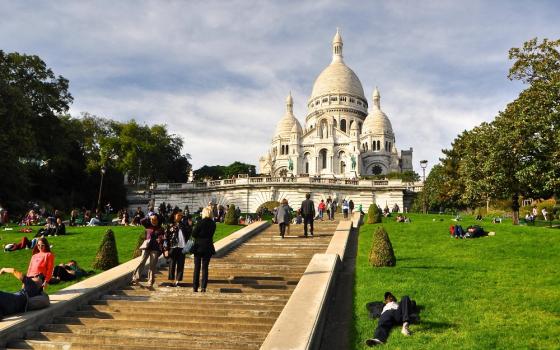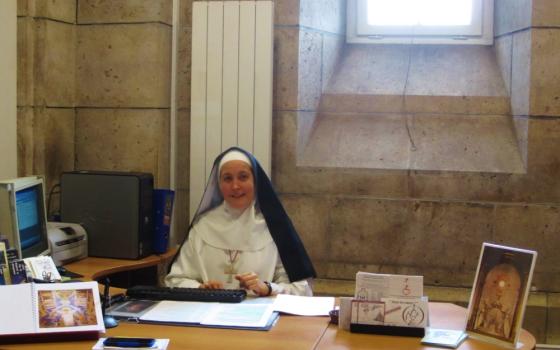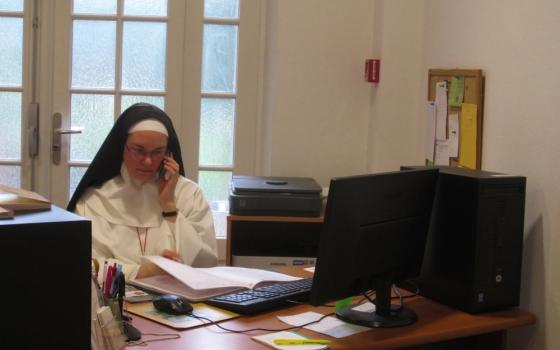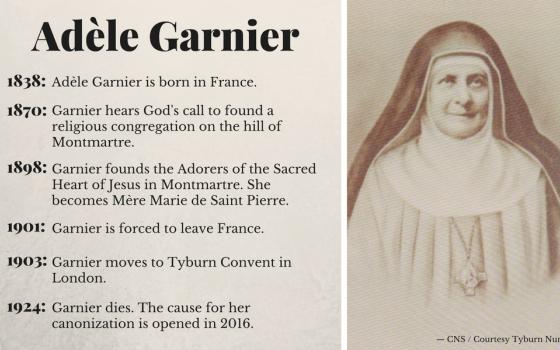Sitting on a bench on the righthand side of the Basilica of the Sacred Heart, also known as Sacré-Coeur, Sister Anne-Christine folds a church bulletin. Next to her, in the aisle, the flow of tourists doesn't stop. Some people look at her and smile, or nod and greet her. Every year, more than 11 million visitors from all over the world come to see this Paris landmark.
"There are two types of visitors: tourists and pilgrims," she said. "The latter come here to pray. What is wonderful is that visitors respect those who pray. Everyone is touched by this place."
The crowd coming to visit this famous basilica, which will celebrate the 100th anniversary of its consecration in 2019, is diverse. The whole world is represented, and conversations take place in many different languages. Safety checks to prevent terrorist attacks mean that lines are long to get in. But this doesn't deter visitors.
"I come to Paris every year," said a woman, Patricia, who lives in Martinique in the French Caribbean. "I need to come here to find new strength. This church is like no other one. I light a candle and pray for a special intention."
She had just finished writing down a special intention on the prayer book nearby. Following her, 8-year-old Myla told her parents to wait for her before leaving the basilica. She, too, wanted to write her wish: "Please, God, bring peace to the world."
Other pilgrims simply come to admire the building: "What strikes me is the artwork, the huge mosaic, the stained-glass windows" said Maria, who was born in Colombia, lives in the Netherlands and does not self-identify as a believer.
Sister Anne-Christine is one of 13 Bénédictines du Sacré-Coeur de Montmartre, a congregation of nuns who follow the charism of St. Benedict, stressing community life and the five religious services: readings, lauds, office of the middle of the day, vespers, and compline. All the sisters take turns playing the zither and leading the singing during Mass.
The sisters are eager to engage in conversation and welcome anyone who comes to the sanctuary. To make this welcome easier, a sister often sits on a bench, folding bulletins. If a pilgrim does not speak French, the sisters use English and Spanish.
"When visitors see me doing something, they find it easier to come and sit by me, perhaps start a conversation," Sister Anne-Christine said.
About halfway on the right aisle of the basilica, next to the souvenir shop, a small office also welcomes visitors. Like in any other church, this is where people ask whether it is possible to have Mass said for someone, to inquire about confession, ask for the blessing of a medal or any sacred object. They also may ask to meet a priest or say a special prayer for someone.
"People talk about all sorts of things," Sister Anne-Christine said. "They talk about God and religion, but also about their life, their worries. Life is not easy for a lot of people. A lot of them are burdened by difficulties. We listen as best as we can."
The little office is closed several times a day during the services and when Mass is celebrated. Pilgrims are welcome to attend Mass, including a 10 p.m. Mass each Sunday favored by Montmartre Catholics who spend weekends in the country.
Adoration time is the Benedictines' main ritual. Every night, the doors of the basilica close at 10:30 p.m. following the last Mass. The Blessed Sacrament is then unveiled and exposed in the monstrance. Adoration time begins and lasts all night.
For more than a century, perpetual adoration of the Blessed Sacrament has remained the vocation of the basilica since Cardinal Joseph Guibert, the former archbishop of Paris, established it in 1885. It did not even stop during World War I or World War II: On the night of April 21, 1944, when 13 bombs dropped on the church and shattered all the stained-glass windows, the adoration went on.
Individuals as well as families or youth groups take turns to ensure a presence in the basilica for continuous adoration. Pilgrims have to commit to spending at least an hour in the church. When their time is over, they walk through a large corridor over to St. Ephrem's guesthouse next door, where rooms are available for them to finish the night. Adoration ends at 6 a.m., when the doors of the basilica open.
The sisters also organize retreats for families, students or anyone wishing to spend time with God at the Ephrem guesthouse.
"Most retreats are preached by one of the six chaplains who form the community around the recteur of the basilica and one of us sisters," said Sister Marie Constance, who is in charge of the guesthouse. "The Benedictine rules say we are to worship the Blessed Sacrament and to welcome any pilgrim as if he was the Christ."
According to Paris' official tourism office, the basilica of the Sacré Coeur is the second-most-visited Paris monument, with 10.5 million visitors last year, behind Notre Dame (13.6 million) and before the Louvre and the Eiffel Tower.
"We haven't had time to prepare anything yet, but we hope to be able to organize a solemn celebration for the 100th anniversary of the basilica in 2019," Sister Anne-Christine said.
The history of the basilica has been linked to the sisters of the Adoration of the Sacred Heart of Jesus of Montmartre even before the church was built and the congregation founded.
In 1872, Adèle Garnier, a governess in the west of France, read an article about a plan to build a basilica in Montmartre. She felt God was calling her to found a congregation to worship the Eucharist and had visions of a monstrance exposed in a big church where pilgrims would come for adoration.
When Garnier told this to Guibert, he was not convinced: The basilica was not built yet, and Garnier was not a nun. However, years later, the archbishop established perpetual adoration of the Sacred Heart in a chapel of the basilica on Aug. 1, 1885, before construction of the nave was finished.
The cornerstone for the Sacred Heart Basilica was laid June 6, 1875, on the hill of Montmartre, which means "hill of the martyrs": St. Denis, the first bishop of Paris, is said to have been beheaded there in 258. The completion of the basilica took nearly 50 years. The church was consecrated in 1919, but work went on until 1923.
Garnier's congregation, the Adorers of the Sacred Heart of Jesus of Montmartre, was founded with three sisters in 1897 in a nearby building and established by the French church in 1898. Garnier became Mother Marie de Saint Pierre. These nuns were contemplative, spending most of their days praying and adoring the Blessed Sacrament.
In the beginning of the 20th century, French members of Parliament, accusing church authorities of having too strong an influence on its citizens, passed a law used to limit the role of priests and religious congregations. Monasteries and convents could not be as active as before, and many religious left France.
Mother Marie de Saint Pierre, who had just professed her perpetual vows, decided to leave Paris for London in October 1901. The congregation was relocated to Tyburn Convent two years later. In 1914, the congregation became a separate branch of the Benedictine order, by adopting the rule of St. Benedict, which stressed monastic life, prayer and adoration.
In 1947, the congregation of the Adorers of the Sacred Heart of Jesus of Montmartre was split into two branches: The English sisters stayed in London, and the French sisters went back to France and took the name of Bénédictines du Sacré-Coeur de Montmartre.
But it wasn't until 1961 that the sisters returned to the Sacré-Coeur de Montmartre, invited by Msgr. Maxime Charles, then rector of the basilica. In 1970, they left Montmartre again to set up a few congregations across the country.
In 1995, Cardinal Jean-Marie Lustiger, archbishop of Paris, asked the congregation to play a bigger role in the spiritual and material management of the basilica. A year of celebration of the Jubilee for 125 years of continuous Eucharistic adoration began June 4, 2010.
"Everyone is invited to join our prayer," Sister Anne-Christine said. "The silent adoration before the exposed Blessed Sacrament, true presence of Jesus Christ among us, has been a continuous intercession for the church and for the whole world and an everlasting source of grace, light and peace."
[Elisabeth Auvillain is a freelance journalist based in Paris.]







